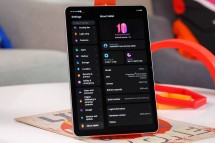Technology
The RedMagic Astra is a small gaming tablet – with its 9.06” display, it’s more portable than most tablets these days and yet it packs a flagship chip and a fast LTPO OLED panel. We received a unit for testing (check out our unboxing here) and have some results to report from our benchmark suite.
First, let us introduce the hardware. The Astra has a 9.06” LTPO display with up to 165Hz refresh rate and 2,400 x 1,504px resolution. It is powered by the Snapdragon 8 Elite – the overclocked AC variant with its two prime CPU cores running at 4.47GHz and its GPU at 1.2GHz (compared to 4.32GHz and 1.1GHz, respectively, for the base AB variant).
Our unit has 16GB of RAM and 512GB storage, though the tablet is available in different configurations ranging from 12GB to 24GB of RAM and between 256GB and 1TB storage. And we should mention that there is an active-cooling fan and liquid metal with superior heat conductivity. However, we will leave sustained performance tests for a later date.
Starting with Geekbench 6, the RedMagic Astra loses out in both single and multi-core performance to another Snapdragon 8 Elite slate, the OnePlus Pad 3. It does beat a previous RedMagic model, the Nova tablet (Snapdragon 8 Gen 3), by 16% and 13% in single and multi-core tests, respectively.
Since this is a gaming tablet, the graphics test perhaps matters the most. Here the RedMagic Astra essentially matches the OnePlus Pad 3. Compared less powerful slates with the Snapdragon 8s Gen 3, the Astra got double the points. And keep in mind that this test runs at a fixed resolution (2160p), so the others don’t have the excuse of higher resolution displays (and their displays are indeed higher resolution, in part because they are larger).
The Astra ends things with a victory in AnTuTu. Its score is 17% higher than the OnePlus and 22% higher than the Nova. This score is close to double what you would get from a Snapdragon 8s Gen 3 powered tablet.
Those are some competitive results, considering that the RedMagic Astra is fairly affordable with prices starting at $470/€470/£410.
We haven’t tested whether the fan has an appreciable effect on the benchmark results yet. That said, you can have a look at how much (or rather how little) it did for the RedMagic 10S Pro. The 10S Pro is a phone, sure, but it uses the same Snapdragon 8 Elite (AC) chipset with the same liquid metal and fan cooling setup.




